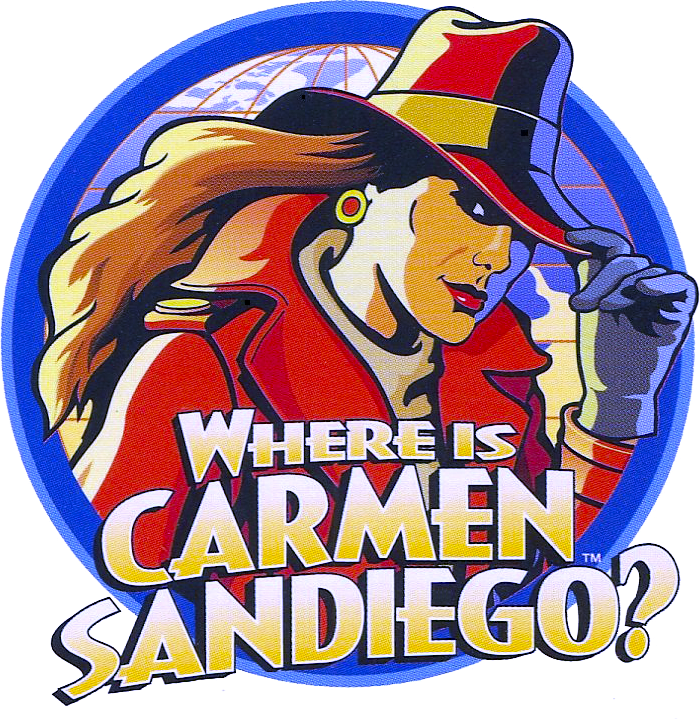Case Study 6
Carmen Sandiego
The Educational TV & Multi-Platform Phenomenon
Overview In Brief
Carmen Sandiego™ is the popular, educational TV animated/action series and e-game series that originated in the mid-1980s, co-created by Brøderbund Software & WGBH-TV (PBS). Originally, the series’ fictitious, female lead character was a master thief who ‘stole’ items that were seemingly impossible to steal, such as the Eiffel Tower from Paris. Her TV series audience members and game players would then solve the mystery of her thefts. Although Carmen’s character persona and plot lines have evolved since the original series, she remains as popular with younger children and kids ages 8-12 as ever. The Carmen Sandiego games series became famous in its own right for its clever explorations of a wide range of different themes and game titles starting with the word, “Where”—including Where In The World Is Carmen Sandiego?, Where In Time (…,), Where In The U.S.A. (…,), etc.
Pocket folder cover art for Carmen Sandiego sales collaterals, our restyled Carmen Sandiego branding, and logo used on licensed product packaging.
The Challenge
There was little or no continuity, i.e. brand consistency in Carmen Sandiego’s character depictions from one TV season, e-game or licensed product to another, and so forth. Consistency being one of the most important aspects of brand integrity, we were tasked with restyling Carmen Sandiego’s likeness, and with creating the first, official Carmen Sandiego Style Guide in the mid-1990s. In addition to Dos & Don’ts on how to properly portray Carmen Sandiego, our style guidance provided a roadmap for licensees and strategic partners to incorporate Carmen and several ancillary characters into their co-branding, product packaging and promotions.
Two examples of how the Carmen Sandiego brand has evolved over time—see also The Difference Between Brand Consistency & Brand Evolution
Outcome & Results
Our work with Brøderbund Software & WGBH-TV (PBS) helped lay the groundwork for the following Carmen Sandiego brand highlights:
• The extraordinary success of Carmen Sandiego, resulting in sales of tens of millions of educational e-game units—and eventual brand extensions across multiple platforms.
• The popularity of Carmen Sandiego resulting in its success as a licensed property—for which we designed packaging and promotional art for several major licensees including Wendy’s, Life Cereal/Quaker Oats, and University Games—among others.
• As an outgrowth of Carmen’s early successes as a series of e-games and a multi-season PBS TV series, ‘she’ continues to thrive, despite the TV and game, etc. rights to this character having been acquired by a string of major entertainment companies over the years including The Learning Company/ Riverdeep UK, DIC Entertainment and Houghton Mifflin Harcourt—as well as a second, separate TV series on the FOX Network.
• In recent years, Carmen Sandiego has been reissued as a smartphone videogame series by Houghton Mifflin Harcourt.
• Most notably, Carmen Sandiego’s latest reincarnation is in the form of a third, separate, four-season TV series on NetFlix.
Carmen Sandiego continues to endure as a popular entertainment icon.
The Important Difference Between Brand Consistency & Brand Evolution
One of THE most important tenets of branding is to maintain consistency in every conceivable respect—from logo fonts, color palette, and brand messaging to stylistic character traits—and every other aspect of a brand’s image and core principles.
Yet, there are obvious, stylistic differences between our original Carmen Sandiego character styling, and how this brand has evolved, since. Why is it important to understand the difference? Evolutionary differences should NOT be confused with a lack of brand consistency. Every animated character of any consequence has evolved over time. One needs only to look no further than Disney’s signature character, Mickey Mouse to see stark differences between the original 1928 character and what we currently see of Mickey in print, animation, toys, and at Disney theme parks.
Similarly, Carmen Sandiego has evolved because this animated character and licensed property’s owners felt the need to re-invent ‘her’ over time, in order to compete with other characters that are popular with the age range of Carmen’s fan base.
The ALL-important difference between a brand’s natural evolution and brand consistency is simple. For the duration of a given time period such as a multi-season TV series, or the period during which an e-game or board game series is popular, conventional brand wisdom dictates that customer expectations of brand consistency be strictly observed. HOWEVER, toward the development of the next (and subsequent) iteration(s) of an animated character in a TV or game series or other forms including toys, plush, etc., savvy brand managers are constantly gauging their brand against its competition—tweaking its stylistic traits, and even its core values accordingly—to reflect ever-evolving, increasingly fickle public tastes and trends.





